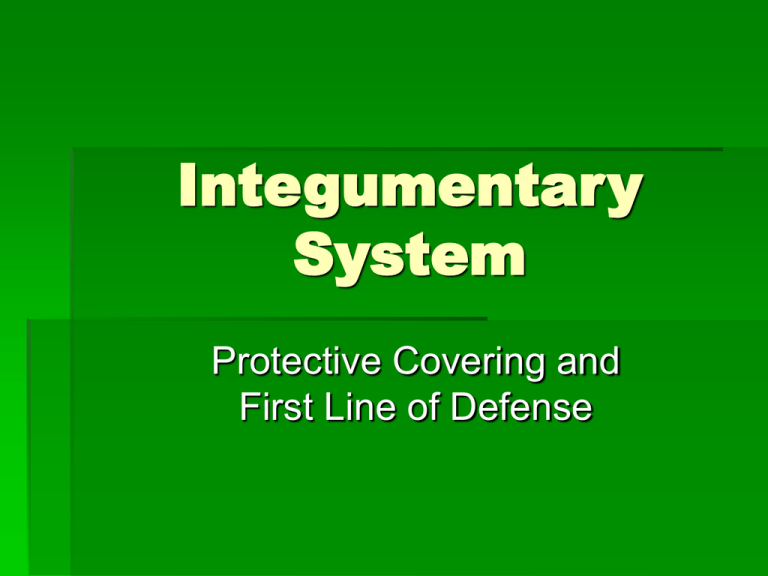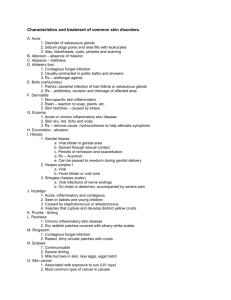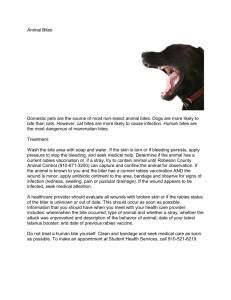skin cancer
advertisement

Integumentary System Protective Covering and First Line of Defense INTEGUMENTARY SYSTEM Skin Called a membrane because it covers the body Called an organ because it consists of several kinds of tissues Largest organ in the body Called a system because it has organs and other parts that work together for a particular function Hair Nails SKIN FUNCTIONS Protection Sensory perception Regulation of body temperature Storage Absorption Excretion Production Skin Trivia 21 Square Feet 4 Kilograms/9 pounds 7% - 15% of Total Body Weight Complex Combination of Tissues Continuous Layer One Square Inch Contains 20 Blood Vessels 65 Hairs & Hair Muscles 78 Nerves 78 Sensors for Heat 13 Sensors for Cold 160 Sensors for Pressure 100 Sebaceous/Oil Glands 1300 Nerve Endings 19,500,000 Cells 0.5 Million Cells Dying & Being Replaced LAYERS OF THE SKIN Epidermis Mostly superficial Complete regeneration every 35-45 days Thinner on scalp and armpit than on sole of foot Dermis Tough, leathery, fibrous connective tissue Wrinkling of elderly = loss of elastin and subcutaneous fat Subcutaneous- Hypodermis Mostly fat Anchors skin to underlying structures GLANDS OF THE SKIN Sudoriferous - Sweat glands 2.5 million per person Cover entire skin surface except for nipples and parts of external genitalia Sebaceous - Oil glands Location: all over the body except for palms and soles of feet Secretion: sebum, oily substance Function: smooth and soften hair and skin; slows water loss during dry weather GLANDS OF THE SKIN Ceruminous Location: outer ear Secretion: earwax/cerumen Mammary Secrete milk from breasts after giving birth Hair and Nails Nails Dead epidermal cells Grows under the lunula (white portion) of nailbed Cells replace if nailbed is healthy Hair Shaft: projects from the skin Root: embedded in the skin; shape determines whether hair is straight or curly Pigment depends on melanocytes located in the follicle SKIN COLOR Melanin Brownish-black pigment Leads to black, brown or yellow skin, depending on racial origin Absorbs UV light to tan the skin Small concentrated areas- freckles SKIN ERUPTIONS Macules Flat spots; freckles Papules Firm, raised areas; pimples, syphilis Vesicles Blisters or sacs filled with fluid; chicken pox Pustules Sacs filled with pus; acne, pimples Crusts Areas of dried pus and blood; scabs Wheals Itchy elevated areas; hives, insect bites Ulcer Deep loss of skin surface that may extend into dermis COMMON INJURIES Abrasion Incision Laceration Puncture Avulsion Amputation Bruises Blisters Severe Bleeding Burns Common Diseases Acne Dermatitis Impetigo Vitiligo Cancer ACNE Occurs when the hair follicles of the skin become plugged with oil and dead skin cells Whitehead plug may block the pore, causing the follicle wall to bulge Blackhead the pore stays open and traps dirt, the top surface of the plug may darken, Pimples Raised red spots with a white center that develop when blocked pores become inflamed or infected Cysts Blockages and inflammation that develop deep inside hair follicles producing lumps beneath the surface of the skin ACNE TREATMENT Treatments work by reducing oil production speeding up skin cell turnover fighting bacterial infection Or doing all three Treatments for acne Lotions Antibiotics or other medications Oral contraceptives Cosmetic surgery DERMATITIS Also called eczema An inflammation of the skin Involves swollen, reddened and itchy skin. Common, not life-threatening and not contagious. Can make one feel uncomfortable and selfconscious IMPETIGO Occurs when bacteria enter the skin through cuts, scrapes or insect bites, Starts as a red sore that quickly ruptures, oozes for a few days and then forms a yellowish-brown crust that looks like honey or brown sugar Highly contagious - infection may spread to other parts of the body and to other people Treated with an antibiotic ointment or oral antibiotics VITILIGO Condition in which the skin loses its pigment cells Results in white patches that appear on the skin in different areas of the body May appear at any age but most often occurs before age 50 The cause is not clear May be due to an immune system disorder Increased incidence of vitiligo in some families No treatment for this disorder has proved effective in all cases VITILIGO SKIN CANCER The abnormal growth of skin cells Most common form of cancer diagnosed Doctors diagnose skin cancer in approximately 1 million Americans each year About 9,800 Americans die annually of skin cancer SKIN CANCER All three types of skin cancer are on the rise. Fair-skinned people who live in areas that get a lot of sunshine are at greatest risk Most commonly caused by overexposure to ultraviolet radiation from the sun Preventable by limiting or avoiding exposure to UV radiation and by detecting changes in skin at an early stage SKIN CANCER SIGNS AND SYMPTOMS A change on the skin is the most common warning sign of skin cancer Can appear suddenly, or it can develop slowly. May appear as a small growth or as a sore that bleeds, crusts over, heals and then reopens. Develops mainly on areas of skin exposed to a lot of sun, including your scalp, face, lips, ears, neck, chest, arms and hands, and on the legs in women First sign of melanoma may be a change in an existing mole or the development of a new, suspicious-looking mole Three major types of skin cancer Basal cell & Squamous cell Both are superficial, slow growing and highly treatable, especially if found early Melanoma A more serious form of skin cancer Affects deeper layers of the skin and has the greatest potential to spread to other tissues in your body SKIN CANCER Basal cell cancer A pearly or waxy bump on your face, ears or neck A flat, flesh-colored or brown scar-like lesion on your chest or back Squamous cell cancer A firm, red nodule on your face, lips, ears, neck, hands or arms A flat lesion with a scaly, crusted surface on your face, ears, neck, hands or arms Mole or Melanoma? Mole Melanoma Melanoma is the least common but most dangerous skin cancer. It can develop anywhere on your body at any age. A large brownish spot with darker speckles A simple mole that changes in color or size or consistency A small lesion with an irregular border and red, white, blue or blue-black spots SCALP CANCER Squamous cell cancer Basal cell cancer Melanoma Doctor should check any lesion that: Has color Grows rapidly Bleeds Gets irritated Tanning beds: Are they safer than the sun? Both sunlight and tanning beds raise the risk of skin cancer and premature skin aging. Exposure to ultraviolet (UV) radiation — found in sunlight and tanning beds — damages skin. The UV source used in tanning beds gives off high doses of UVA — up to three times more than in sunlight. Also, the UV light from tanning beds may: Cause eye burns if protective eyewear is not used. Worsen some chronic conditions such as lupus and diabetes. BURNS First degree Second degree Third degree Severe Burns Main causes of death due to burns include Bacterial infection Severe loss of body fluids from the burned surface Dehydration, which can impair circulation and blood supply to vital organs and lead to kidney failure Burn centers provide specialized care for people who are badly burned BLISTERS Keep intact - unbroken skin over a blister provides a natural barrier to bacteria and decreases the risk of infection If the blister is painful Wash the blister with warm water and soap. Swab the blister with rubbing alcohol. Sterilize a clean, sharp needle by wiping it with rubbing alcohol. Use the needle to puncture the blister. Aim for several spots near the blister's edge. Let the fluid drain, but leave the overlying skin in place. Apply an antibiotic ointment to the blister and cover with a bandage. BRUISE Forms when a blow breaks small blood vessels near your skin's surface, allowing a small amount of blood to leak out under your skin Trapped blood appears as a black-and-blue mark If the skin isn't broken, you don't need a bandage. Elevate the injured area. Apply ice or a cold pack for 30 to 60 minutes at a time for a day or two after the injury. ANIMAL BITES For minor wounds. If the bite barely breaks the skin, treat it as a minor wound. Wash the wound thoroughly with soap and water Apply an antibiotic cream to prevent infection Cover the bite with a clean bandage. For deep wounds. If the bite creates a deep puncture of the skin or the skin is badly torn and bleeding, Apply pressure to stop the bleeding and see the doctor For infection. If signs of infection such as swelling, redness, increased pain or oozing occur, see the doctor immediately. For suspected rabies. If you suspect the bite was caused by an animal that might carry rabies — any bite from a wild or domestic animal of unknown immunization status — see the doctor immediately HUMAN BITES Treatment of a human bite that breaks the skin Stop the bleeding by applying pressure. Wash the wound thoroughly with soap and water. Apply an antibiotic cream to prevent infection. Apply a clean bandage. Get emergency medical care. A tetanus booster shot, if more than ten years INSECT BITES AND STINGS For mild reactions: Try to remove the stinger Swab the site with disinfectant. Apply hydrocortisone cream, calamine lotion or a baking soda paste Give victim an antihistamine For severe reactions: Severe reactions may progress rapidly. Dial 911 or call if any of the following signs or symptoms: Difficulty breathing Swelling of the lips or throat Faintness, confusion, rapid heartbeat Hives Nausea, cramps and vomiting HIVES Also known as urticaria Raised, red, often itchy welts (wheals) of various sizes that appear and disappear on the skin. Angioedema, a similar swelling, causes large welts deeper in the skin, especially near the eyes and lips Affects about one in five people Can be life-threatening if swelling causes the throat or tongue to block airway and lead to loss of consciousness. Hereditary angioedema (HAE) Uncommon, inherited disorder, which can cause sudden, severe and rapid swelling of the face, arms, legs, hands, feet, genitalia, digestive tract and airway. HEATSTROKE Main sign of heatstroke is an elevated body temperature — generally greater than 104 F Changes in mental status ranging from personality changes to confusion and coma. Skin may be hot and dry, although in heatstroke caused by exertion, the skin is usually moist. Other signs and symptoms may include: Rapid heartbeat Rapid and shallow breathing Elevated or lowered blood pressure Cessation of sweating Irritability, confusion or unconsciousness Fainting, which may be the first sign in older adults




![First Aid Training : Bronze [Power Point]](http://s2.studylib.net/store/data/005424634_1-e0b0e5e602f7c1666ebc2e9ff3f4a1b5-300x300.png)

